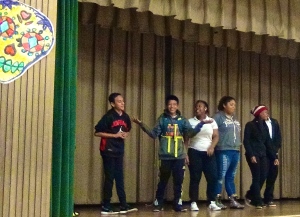By Laila Copperansky, Performing Arts Workshop Intern

Students at Paul Revere use spoken word poetry to explore self-identity and issues of race and ethnicity. Photo credit: Laila Copperansky
This fall, I’ve had the pleasure of being a fly on the wall for four of core artist Rahman Jamaal’s middle school spoken word classes at Paul Revere College Preparatory School in Bernal Heights. The combination of rap music and middle schoolers has resulted in an exploration of self-identity and issues of race and ethnicity. Rahman’s curriculum combines both the technical and the artistic aspects of hip hop. His lessons span topics such as rhythm, rhyme, and the structure of rap and provide students with ample opportunities to express their own beliefs through dialogue and written work.
In September students began to learn how to differentiate rhythms by practicing simple counting exercises. They moved on to identify these rhythms while watching other artists’ music videos, including the music video “I am Malala”, which is performed by young girls from around the world who use the platform of rap music to spread awareness of Malala’s message and advocate for girls’ right to education. This ignited a series of fascinating reactions and comments from students, who were shocked to see a group of girls their own age with a clear sense of rhythm and the confidence to share a strong message in a rap. These reactions led to questions about Malala herself, and the powerful realization by one student that this video was about “fighting for your rights using words!”
Students are continuing to expand their understanding of the technical, artistic, and expressive aspects of rap. In a recent class, students began to demonstrate that they are ready to connect their personal identities to their brainstorming and writing during class. In late October, Paul Revere hosts a “Latin Heritage Day” during which the school celebrates a culture and ancestry which many of their students share. Rahman’s class has agreed to write a “group rap” which they will perform at the event. Students started by brainstorming aspects of Latin Heritage from which they could be inspired to write a rap. The list began with foods and then moved on to Latino celebrities. When prompted by Rahman to think about the origins of Latin culture, students began to call out words like “Mayan” , “Aztec”, “Quetzalcoatl” and “Montezuma”. Eventually, two powerful topics emerged: the Mexican legend of “La Llorona” (which may have originated from the story of an indigenous woman who betrayed her people by becoming Cortez’s mistress) and the challenges of Latino children who immigrate to the United States without their parents. These topics reflect both the injustices of the past and of the present, while also providing a powerful opportunity for students to connect and reflect upon their own experiences and identities.
Students have the unique opportunity to immerse themselves in Rahman’s class four times a week, which adds an unusual intensity to their experience. Since this is only the beginning of Rahman’s thirty week program, students’ explorations and discoveries will continue to evolve until the end of the school year.
